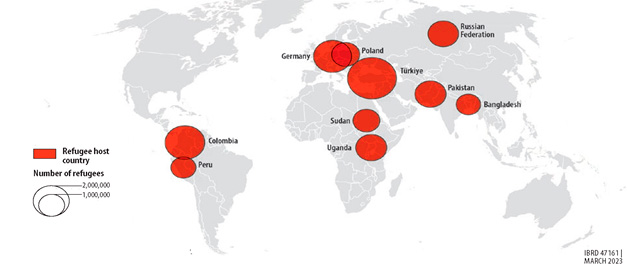|

|
WORLD DEVELOPMENT REPORT 2023
MIGRANTS, REFUGEES, AND SOCIETIES
Washington DC, 2023, World Bank, 348 pages
|
https://www.worldbank.org/en/publication/wdr2023
|

Во многих странах ОЭСР с высоким уровнем дохода натурализовано
более половины лиц, родившихся за границей (стр. 24)

Доля эмигрантов в населении в разбивке по группам
стран с доходом, 1960, 1990, 2020 годы (стр. 46)

Доля иностранцев в населении в разбивке по странам
и группам доходов, 1960, 1990, 2020 годы (стр. 46)

Примечание: Пузырьки, указывающие на количество
беженцев, расположены в центре каждой принимающей страны,
а не над конкретными субрегионами, где размещаются беженцы.
Десять стран принимают более половины всех беженцев
(стр. 55)

Доля мигрантов, покидающих Западную Европу, в
разбивке по полу и региону происхождения (%) (стр. 106)

Число погибших или пропавших без вести мигрантов
в разбивке по регионам происхождения (стр. 249)
|
В Докладе о мировом развитии 2023 года предлагается
комплексная структура для максимизации воздействия трансграничных
перемещений на развитие как стран назначения, так и стран происхождения,
а также самих мигрантов и беженцев. В докладе предлагается основа
для наилучшего управления экономическими, социальными и гуманитарными
последствиями миграции. Объединяя знания из области экономики труда
и международного права, он рассматривает степень востребованности
навыков и качеств мигрантов в месте их назначения (соответствие)
и то, ищут ли они возможности или опасаются за свою жизнь в стране
происхождения (мотив). В нем проводится различие между четырьмя
различными типами перемещений и определяются приоритетные стратегии
и мероприятия для полной реализации преимуществ развития во всех
ситуациях. Для осуществления перемен решающее значение имеет международное
сотрудничество
Contents
Foreword
Acknowledgments
Key takeaways
Glossary
Abbreviations
Overview
Migration is necessary for all countries
A practical framework for policy makers: The Match and Motive
Matrix
When the match is strong, the gains are large
When the match is weak, the costs need to be shared-and reduced-multilaterally
Making migration work better requires doing things differently
A message of hope
Notes
References
Chapter 1: The Match and Motive Matrix
Key messages
A people-centric approach
A focus on foreign nationals
Two perspectives: Labor economics and international law
The Match and Motive Matrix
Policy priorities
Notes
References
Spotlight 1: History
PART 1: MIGRATION IS INCREASINGLY NECESSARY FOR COUNTRIES
AT ALL INCOME LEVELS
Chapter 2: The numbers: Understanding who moves, where
to, and why
Key messages
Current trends
Motives and patterns
Notes
References
Spotlight 2: Data
Chapter 3: The outlook: Changing patterns, needs, and
risks
Key messages
Demographics: The coming competition for workers
Climate change: New risks of distressed movements
Notes
References
Spotlight 3: Methodological considerations
PART 2: WHEN THE MATCH IS STRONG, THE GAINS ARE LARGE
Chapter 4: Migrants: Prospering-and
even more so with rights
Key messages
Receiving higher wages
Accessing better services
Dealing with social costs
Returning
Failing, sometimes
Notes
References
Spotlight 4: Gender
Chapter 5: Origin countries: Managing migration for
development
Key messages
Reaping the full development benefits of remittances
Leveraging knowledge transfers
Managing labor market impacts
Taking a strategic approach
Notes
References
Spotlight 5: Measurement of remittances
Chapter 6: Destination countries: Maximizing gains through
economic and social policies
Key messages
Benefiting from migrants' labor
Maximizing economic gains
Fostering social inclusion
Notes
References
Spotlight 6: Racism, xenophobia, and discrimination
PART 3: WHEN THE MATCH IS WEAK, THE COSTS NEED TO BE
SHARED-AND REDUCED-MULTILATERALLY
Chapter 7: Refugees: Managing with a medium-term perspective
Key messages
Recognizing the development challenge
Enhancing responsibility-sharing through regional solidarity
Going beyond emergency responses
Making progress toward durable solutions by combining legal status
and access to opportunities
Notes
References
Spotlight 7: Internal displacement and statelessness
Chapter 8: Distressed migrants: Preserving dignity
Key messages
Acknowledging policy trade-offs
Extending international protection
Shifting migrants' incentives through legal pathways
Strengthening the match of migrants' skills and attributes through
development
Notes
References
Spotlight 8: "Root causes" and development
PART 4: MAKING MIGRATION WORK BETTER REQUIRES DOING
THINGS DIFFERENTLY
Chapter 9: Recommendations: Making migration work better
Key messages
Introduction
Strong match: Maximize gains for all
Weak match and fear motive: Ensure the sustainability of refugee-hosting,
including through responsibility-sharing
Weak match and no fear motive: Respect dignity and reduce the
need for distressed movements
Essentials for reform
Notes
References
|

